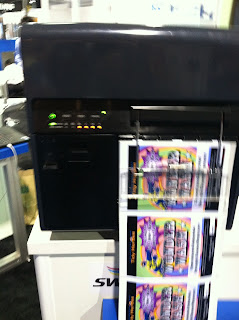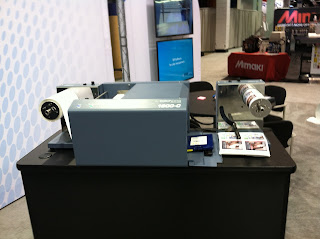But before I give my specific views, I like to make one
observation for all these companies. All
of these companies showed examples of printing “Prime” labels. If you don’t know, a prime label acts as the main identification of
a product. This label is designed to attract attention; and contains
information to appeal to a buyer. Most prime labels are produced by printers
or in print shops. The labels shown by these companies were
100% covered with ink, commonly referred to as “flood coated”.
In the Primera booth,
I discussed the LX900 with the sales representative: http://www.primeralabel.com/lx900_features.html.
 |
| Primera LX900 with labels |
In the booth, Primera was using the LX900 to print this
prime label covered with 100% ink.
 |
| Primera Produced Prime Label |
With 4,800 dpi and 4 colors, this $2,995 list price printer
produces prime labels for products such as wine or olive oil very well. However, this printer runs very slow at
higher resolution, comes only with a USB interface and uses die-based inks that
may run or smear when wet.
 |
| SwiftColor 8" printer |
 |
| SwiftColor 4" printer |
According to the person I met in the booth, the $10,000+,
4”, 4-color printer uses die-based inks to print up to speeds of 8” per second.
 |
| SwiftColor 8" Prime Label |
 |
| SwiftColor 4" Prime Label |
They could not tell me when the 8” version would be
available.
 |
| Colordyne printer |
 |
| Colordyne printer |
The 1600 S is similar to the 1600 C, but prints only
sheet-fed stock.
According to the people I spoke with in the booth, these
printers cost between $10,000 and $15,000.
Here is example of the prime labels they were printing in their booth:
 |
| Colordyne Prime Label |
 |
| Speedstar |
With a built-in computer and software, this 12” per second, 4-color,
$23,500+ prime label printer produced very good labels that were shown going
through a cutter after printing.
 |
| Speedstar Label (black smudges are from my scanner) |
Although fast and high
resolution, Memjet may have trouble printing in the real world: http://www.large-format-printers.org/mems-printheads-memjet-printers-reality-check.php
Some of you may be wondering, why am I making you aware of
these companies? From my perspective,
the more companies promote on-demand color labels, the more the entire market
for this technology will grow. I see
this growth increasing the global automated data capture/barcode printer
business significant; and a real opportunity for value added resellers in this
market. So the more companies, the
merrier for you!
Guy Mikel

No comments:
Post a Comment